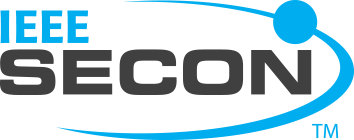The 19th annual IEEE International Conference on Sensing, Communication and Networking (SECON) will provide a unique forum to exchange innovative research ideas, recent results, and share experiences among researchers and practitioners in wireless and mobile communication networks. The conference aims to serve as the reference exhibit for state-of-the-art research supported by implementation and insights gained on all scales of experimental systems, network architectures, components, and protocols.
Looking beyond current sensing, communication, and networking paradigms, IEEE SECON continues to emphasize pioneering cross-disciplinary work as its signature footprint in the contemporary research landscape. Towards that end, SECON encourages work that falls at the intersection of traditional sensing/networking and new disciplinary areas including (but not limited to) machine intelligence, data analytics, edge computing, social networks, rural connectivity, electromagnetic fields, to name a few, encompassing topics ranging from biological communication and computing networks to uncharted wireless bands, edge intelligence, social media data exploitation, mobile data analysis and beyond 5G networking/communications aspects. Papers describing original, previously unpublished research, experimental efforts, practical experiences, as well as visionary roadmaps, in all aspects of sensor networks, Internet of Things, mobile devices, and wireless communication are solicited. Particular topics of interest include, but are not limited to:
- New communication paradigms, such as Terahertz communications, optical Wireless communications, visible light communication, acoustic communication, and uncharted wireless bands, reconfigurable intelligent surfaces
- New platforms, techniques, and hardware designs for sensing
- Cellular communications and data networks, including 5G and beyond
- Internet of Things, Nano-Things and Bio-Nano-Things; Cyber-Physical systems
- Software defined and programmable networks
- Intra-body networks and molecular communication networks
- Unmanned aerial vehicle (UAV)-based sensing/communications/networking
- Low-power and energy limited sensing and communications
- Communication and networking for AI and machine learning
- Data analytics, AI, and machine learning for sensing, communication, and networking
- Sensing, communication, and networking in challenging scenarios (e.g., underground, underwater, rural and low-income areas, COVID-19 pandemic, space)
- Time and location management in networking systems
- Sensing and networking of social systems
- Fairness and Socio-technical issues in networking
- Security, privacy, and trustworthiness of mobile, wireless and sensor systems
- Cloud, Edge, and Fog computing for sensing and inference
- Novel experimental testbeds for sensing and networking systems
- Measurement of sensing and networking systems
- Sensing and Networking for Smart & Connected Communities
- Deployment experiences in sensing, communication, and networking
- Next generation applications such as wearable computing, virtual/augmented reality, autonomous driving, industrial internet, and smart cities, agriculture, industry, energy, transportation, water, and other smart infrastructural systems
Selected accepted papers will be fast-tracked to ACM Transactions on Sensor Networks (TOSN) for publication.
PAPER SUBMISSION AND PUBLICATION
Papers should neither have been published elsewhere nor be currently under review at another venue. All papers for IEEE SECON 2022 must be submitted via the conference submission page. Each submission must be no longer than 9 pages and in font size no smaller than 10 points. Submissions that violate the formatting guidelines will be rejected without review.
All submitted papers will be judged based on their quality and relevance through double-blind reviewing, where the identities of the authors are withheld from the reviewers. As an author, you are required to preserve the anonymity of your submission, while at the same time allowing the reader to fully grasp the context of related past work, including your own. Common sense and careful writing will go a long way towards preserving anonymity. Papers that do not conform to our double-blind submission policies will be rejected without review.
Submitted papers should be written in the English language, with a maximum length limit of 9 printed pages, including all the figures, references, and appendices. Papers longer than 9 pages will not be reviewed. Use the standard IEEE Transactions templates for Microsoft Word or LaTeX formats at https://www.ieee.org/conferences/publishing/templates.html. If the paper is typeset in LaTeX, please use an unmodified version of the LaTeX template IEEEtran.cls version 1.8, and use the preamble:
\documentclass[10pt, conference, letterpaper]{IEEEtran}
Do not use additional LaTeX commands or packages to override and change the default typesetting choices in the template, including line spacing, font sizes, margins, space between the columns, and font types. This implies that the manuscript must use 10-point Times font, two-column formatting, as well as all default margins and line spacing requirements as dictated by the original version of IEEEtran.cls version 1.8. A smaller font size, up to 8pt, is allowed for reference pages. You can ignore any warning of the submission system for the reference pages.
If you are using Microsoft Word to format your paper, you should use an unmodified version of the Microsoft Word IEEE Transactions template (US letter size). Regardless of the source of your paper formatting, you must submit your paper in the Adobe PDF format.
The paper must print clearly and legibly, including all the figures, on standard black-and-white printers. Reviewers are not required to read your paper in color.
The organizers of IEEE SECON 2022 as well as our attendees expect accepted papers to be presented at the conference. IEEE reserves the right to exclude a paper from distribution after the conference (e.g., removal from IEEE Xplore) if the paper is not presented at the conference.
Submit your papers via EDAS at: https://edas.info/newPaper.php?c=29537&track=111501
IMPORTANT DATES
Abstract Registration: 2 May 2022 9 May 2022
Paper Submission: 9 May 2022 16 May 2022
Acceptance Notification: 15 July 2022
Paper Final Version Due: 29 July 2022 31 August 2022 (Final Extension)


